- Home
- Peter Ackroyd
The Clerkenwell Tales
The Clerkenwell Tales Read online
The Clerkenwell Tales
Peter Ackroyd
NAN A. TALESE | DOUBLEDAY
New York London Toronto Sydney Auckland
Contents
Title Page
List of Characters
The Prioress’s Tale
The Friar’s Tale
The Merchant’s Tale
The Clerk’s Tale
The Canon’s Yeoman’s Tale
The Franklin’s Tale
The Nun’s Priest’s Tale
The Knight’s Tale
The Reeve’s Tale
The Physician’s Tale
The Monk’s Tale
The Manciple’s Tale
The Summoner’s Tale
The Miller’s Tale
The Wife of Bath’s Tale
The Cook’s Tale
The Squire’s Tale
The Man of Law’s Tale
The Pardoner’s Tale
The Shipman’s Tale
The Parson’s Tale
The Second Nun’s Tale
The Author’s Tale
About the Author
Other Books by Peter Ackroyd
Copyright Page
List of Characters
The reader may recall that many of the characters within this narrative are also to be found in The Canterbury Tales by Geoffrey Chaucer. As William Blake remarked, “the characters of Chaucer’s pilgrims are the characters which compose all ages and nations: as one age falls, another rises, different to mortal sight, but to immortals only the same . . .”
Dame Agnes de Mordaunt, prioress
Dame Alice, procuratrix
Garret Barton, franklin
Coke Bateman, miller
Bogo, summoner
Henry Bolingbroke, claimant to the throne
Oliver Boteler, squire
Robert Braybroke, Bishop of London
Sister Bridget, second nun
Geoffrey de Calis, knight
Sister Clarice, nun
Drago, canon’s yeoman
John Duckling, nun’s priest
William Exmewe, Augustine friar
John Ferrour, parson
Hamo Fulberd, illuminator
Thomas Gunter, physician
Emnot Hallyng, clerk
Gabriel Hilton, jeweller
Janekin, apprentice
Jolland, monk
Oswald Koo, reeve
Dame Magga, hosteler
Gybon Maghfeld, squire
Richard Marrow, carpenter
Martin, man of law
Brank Mongorray, monk
Robert Rafu, manciple
Richard II, King of England
Gilbert Rosseler, shipman
Anne Strago, merchant’s wife
Radulf Strago, merchant
William Swinderby, canon
Umbald of Arderne, pardoner
Miles Vavasour, sergeant-at-law
Roger Walden, Archbishop of Canterbury
Roger of Ware, cook
Chapter One
The Prioress’s Tale
Dame Agnes de Mordaunt was sitting in the window of her chamber, looking out over the garden of the House of Mary at Clerkenwell. Her aunt had been prioress before her, and she assumed familial responsibility for the acres as well as the souls under her care. The garden was called “Forparadis,” “Out of Paradise,” but on this mild February morning it seemed blessed with the air of Eden itself. It was triangular in shape, in commemoration of the Blessed Trinity, and there was a triangular bed on each side. The three paths connecting them had been constructed with thirty-three flagstones; the three walls around the garden, each one of thirty-three feet, were built out of three layers of stone – pebble stone, flint and rag stone. Some lilies had been planted round a cherry tree in token of the Resurrection, and in the language of flowers might spell the words she knew by heart, “The just man will grow like the lily, and he will flourish in the sight of God.” But then Dame Agnes sighed. Who could bring more unhappiness upon this house? Who can give more heat to the fire, or joy to heaven, or pain to hell?
In the open fields beyond the walled garden, stretching down to the river, she could see the malt-house with its dovecote, the familiar cart-house, and the turf-house beside the stables. On the western bank of the Fleet river stood the mill-house and, on the other side, a cottage of whitewashed walls and thatched roof which belonged to the bailiff of the convent. The miller and the bailiff were engaged in a protracted lawsuit over their rights to the river which flowed between them. They had often taken one of the Thames barges from the mouth of the Fleet to Westminster in order to press their cases with a judge or a sergeant-at-law, but nothing had been resolved; the boat costs twopence, the bailiff had said to Agnes, but the law costs a man everything. The prioress had tried to intercede but had been told by her cellaress, among others, that she might as well spread honey among thorns.
She could smell the steam coming from the kitchen across the cloister, and could hear the clatter of brass plates being washed for bread and beef after prime. Would the world always run in this way until the day of doom? We are like drops of rain, falling slantwise to the earth. Her monkey, sensing her melancholy, clambered upon her shoulders and began to play with the gold ring suspended on a silken thread between her breasts. She sang to it a new French song, “Jay tout perdu mon temps et mon labour,” and then played handy-dandy with a hazelnut.
She had entered the House of Mary while still a young girl, and had somehow maintained the dazed demureness of her childhood. But she could also be excitable and irascible, taking pride in her exalted position as a child might. Some of the younger nuns whispered that, on Innocents Day, she ought to couple with the Boy Bishop. Her chamber was hung with green cloths, together with curtains of green velvet. Green was the colour considered to be friendly to the underworld spirits. It were wise, she had said, not to wake the well. This clerk’s well lay just beyond the stone wall of the convent, a few feet from the infirmary, and was deemed to be a sacred place.1
At this hour of the morning she drank either ypocras or claree, the sweet wine soothing her stomach made tender by the ordeals which she had recently endured. Rumours of the strange events within the convent had already reached as far as the cookshops of East Cheap and the fish-stalls of Friday Street; although Agnes had not been informed of these somewhat garbled reports, she was aware of a strange disquiet in the vicinity and felt uneasy. She dipped her finger into the wine and honey before giving it to her monkey to suck. “The first finger is the little man,” she murmured to it in a childish voice which would have embarrassed her in company. “This is the leech finger, for it is the one that the physician uses. The next is called the long man. This one here is the toucher or lick-pot. Do you see? I touch your nose with it.” There was a sharp rap upon the door, and she rose quickly from the window seat. “Who is knocking?”
“Idonea, ma dame.”
“Enter in God’s name, Idonea.”
The sub-prioress, an elderly nun whose face was as raw and as pitted as over-salted meat, hardly waited for the invitation. She made a hurried pretence at bowing, but it was clear that she could not contain her excitement. “She has fallen into a fit. She is speaking in another voice than her own rightful voice.”
Agnes looked with pity, as always, at the ill-favoured visage of Idonea. “She is fighting with God.”
There was no need to explain who “she” was. The mad nun of Clerkenwell, Sister Clarice, had been conceived and born in the tunnels beneath the convent.
“Where is she now?”
“In the painted chamber.”
There had been unhappiness before in the House of Mary. A great scandal had been provoked by certain nuns un
der the rule of Agnes’s aunt, Joyeuse de Mordaunt, whose manifest infirmities prevented her from keeping control over her flock.
Two hundred yards from the convent stood the more celebrated priory of St. John of Jerusalem, the house of the Knights Hospitallers. A great congeries of stone buildings, chapels, orchards, gardens, fishponds, wooden dwellings and outhouses which stretched as far as Smithfield to the south and the Fleet river to the west, it was an ancient foundation, rendered more sacred by the relics which had been the gifts of several popes, among them a phial of milk from the breasts of the Virgin Mary, a piece of sail-cloth from St. Peter’s boat, a feather from the wings of Gabriel and fragments from the multiplied loaves and fishes. Only recently the senses of a man, dumb and blind from birth, had been restored by a drop of the Blessed Mother’s milk. The priory was a church and hostel for travellers, as well as a hospital and large working farm, but twenty years before it had also acquired a reputation for licentiousness. In the words of the cardinal legate who had been sent by the pope to investigate the matter, it had harboured “nervous and demoniacal merriment” together with “dances and lascivious games.”
Everyone agreed that it had been the fault primarily of the young nuns. It was remarked how eager they had become to cross the green of Clerkenwell in order to confess to the priests attached to the priory, and it soon became clear that confession was not their main purpose. The cellarer of the priory had told the kitcheness of the convent that the nuns had been observed dancing and playing the lute; as he put it to her, “the devil was dancing on their heads.” Some of the nuns had draped strings of small bells about their necks, which prompted the kitcheness to call them “the devil’s cows.” It was said that the mistress of the novices had thrown away her birch in sympathy, and had joined her charges in all this wantonness. It was also noted that several of the younger nuns were absent at vespers or at compline. Dame Joyeuse de Mordaunt suffered from the palsy, and could in no way be made to understand the seriousness of these reports.
But the disorder had grown so great that the prior of St. John felt obliged to seek an audience secreto with the Bishop of London. The bishop duly ordered a visitation, reminding the prior of the text “Evil shall have that evil will deserve,” and in person interviewed every nun in the convent of St. Mary. In the report of these proceedings, it was revealed that there had indeed been much running and leaping and flying, much lifting up and discovering, among the monks and nuns. But there were other enormities. Certain of the nuns admitted to clandestine meetings with the male servants of the convent in the cart-house and in the bake-house; even the church itself had become a place of assignation. It was often said by the citizens that nuns were fond of ginger hot in the mouth, and now the popular aphorism had been decisively proved. A cook, a porter, a gardener and cowherd were as a result discharged, while the errant nuns were despatched to other convents in disgrace. By dispersing them it was hoped, according to the bishop, that all their heat would be turned to cold.
The most shocking discovery came last, however, when it was revealed by the infirmaress, Sister Eglantine, that there existed a series of passages running beneath the earth between the priory and the convent. Their construction pre-dated the foundation of both religious houses, and their original purpose could not be divined, but they had been employed in more recent years as a convenient gateway for those who did not wish to be seen above the ground. In the bishop’s secret report, sent under seal to Rome, it was also disclosed that certain infants born of the illicit union between monk and nun were kept in these subterranean tunnels until they were of an age to join the life of the religious institutions without scandal. Such a child was Clarice, whose behaviour now so troubled the repose of Agnes de Mordaunt.
The vengeance of God had been swift. In the year of Clarice’s birth, 1381, the ragged army of Wat Tyler had stormed and burned the priory of St. John; the prior himself had been beheaded on Clerkenwell Green. As the fire raged the nuns of the House of Mary brought Joyeuse de Mordaunt before the rebels as an emblem of their weakness and helplessness. “The Virgin protects us,” they had called out to Tyler.
He had laughed and raised his hat in greeting; he had already dipped its feathers in the blood of the prior. The nuns had feared rape, but endured only a few loud and salacious remarks. The convent was spared but, three months later, the elderly prioress died of apoplexy. Her last words were, “The head was off before his hat was on.”
Agnes de Mordaunt adjusted her veil and wimple in order to ensure that her forehead was covered before leading Sister Idonea out of the chamber; she tied her monkey with a long ribbon to the base of her close-stool and, taking up her crozier, proceeded down the stone stairway to the refectory. Before confronting Sister Clarice she wished to ensure that the others were quiet. She found them finishing their beef and bread. Sister Bona, the sub-chantress, was reading aloud from the Vitis Mystica, and was expounding the five wits of hearing, sight, smelling, feeling and chewing. When Agnes entered she stopped, and the others rose at the table.
The nuns of course observed the rule of silence, and employed their hands in sign language to receive salt or beer; to ask for salt, for example, it was necessary to put the right thumb over the left thumb. Agnes suspected, however, that there had been a slight murmur of words before her arrival, a little whisper of “sic” or “non” as Sister Bona had maintained her slow and steady reading of the treatise. If any nun had been caught she would have been compelled to eat in the convent cellar with the infirm and the feeble-minded but, under the gaze of Dame Agnes, each one preserved her decorum. The prioress passed through, acknowledging their reverence with the smallest bow of the head, but she could not resist a sidelong glance at Sister Beryl who was smiling broadly at her. It was no sin to smile, especially since the holy scriptures had taught that we would all be merry in heaven, but Beryl’s expression angered Agnes; it was the anger of a child left out of the game.
Sister Idonea walked softly behind and, as they left through the side door of the refectory, she slipped upon the cobbles. “You should not walk wet-shod.” Agnes could hardly keep her countenance and resist laughing. “The stones are treacherous.”
They walked across the cloister to the painted chamber, a small room beside the chapter-house which was used by the treasuress as her office.
Sister Clarice was standing in a corner, her hands folded across her chest.
“Where be the gay robes and the soft sheets and the little monkey playing with a ring?” The prioress said nothing. “Agnes, you will conceive of a holy man and give birth to the fifth evangelist.” Clarice was only eighteen years, but already her voice was possessed of an implacable authority.
Agnes could feel herself trembling. “Listen, cocatrice, I will send you to do penance among the lepers of St. Giles.”
“And I shall teach them the words of Jesus the flower-maker.”
“Not so. You are the devil’s story-teller.”
“Is it the devil who tells me of the king? Is it the devil who prophesies his undoing?”
“Ave Genetrix! Mother of lies!”
It had all begun with a dream, or a vision. Clarice had fallen into a fever three months before and, while confined to bed, had confided to the infirmaress that she had seen a demon in the shape of a deformed and very ancient manikin going around the dormitory and touching each of the nun’s beds. He had then turned and said to Clarice, “Take careful note of each place, little sister, for they shall not be without a visit from me.” In another dream, or vision, Clarice had fallen upon the demon and beaten him with her fists; he laughed and sprang out of her grasp, saying, “Yesterday I disturbed your sister the chantress much more, but she did not hit me.” On hearing of this strange interview, the chantress herself had become very indignant and demanded that Agnes rebuke Clarice before the whole community in the chapter-house.
Instead Agnes had invited the young nun to her chamber. “You know,” she began, “that there are three forms of dream. There
is that of somnium coeleste or heavenly influence. Your wind does not blow from that corner.”
Clarice laughed out loud. “Purge me with rhubarb, ma dame.”
“Then there is the dream which springs from somnium naturale and your bodily humours. The third comes from somnium animale or dejection of spirits. Can you tell me, Clarice, which of these is yours?” The nun shook her head. “Do you know that your brain is filled with owls and apes?” Clarice still said nothing. “Do you dream of King Richard?”
“Yes. I dream of the damned.”
Agnes ignored her dangerous answer. “A dream is sometimes called a meeting. What is it, then, that comes to you?”
“I am sister to the day and night. I am sister to the woods. They come to me.”
“You are babbling like a child.”
“Why, then, I should go to a dark place beneath the nunnery.”
Dame Agnes walked across the chamber to her and slapped her face. Her monkey began to cry and chatter, and suddenly she felt an overwhelming need to sleep. “I pray that God gives me wisdom enough to reach true judgement. Now go.”
That night Sister Clarice rose from her bed and wept, as if she were being berated by some unseen power. Resisting as much as she could, she seemed to be pushed from the dormitory and into the choir of the church. She lay down in one of the stalls, and began to speak in a low voice. Many of the nuns had now gathered in alarm, among them the infirmaress and the sub-prioress who repeated her words to Dame Agnes the next morning. “He shall awake the waster with water. Before five years are fulfilled such famine will arise through floods and foul weather that fruit shall fail. And so he has warned me. When you see the sun amiss, and two monks’ heads, and a maid has the mastery, and multiply by eight. Then death will draw on and Davy the ditcher will die of despair.” The plague or “death” had come only nine years before, and Clarice’s prophecy was sufficiently alarming to send two nuns into a fit of weeping. The rest looked on, horrified, as Clarice trussed up her habit and in open view placed her hand within her queynte crying, “The first house of Sunday belongs to the sun, and the second to Venus.” Then she fell into a faint, and was carried into the infirmary from which she did not emerge for six days.

 The Clerkenwell Tales
The Clerkenwell Tales The Canterbury Tales
The Canterbury Tales J. M. W. Turner
J. M. W. Turner Chatterton
Chatterton The Canterbury Tales – A Retelling
The Canterbury Tales – A Retelling Alfred Hitchcock
Alfred Hitchcock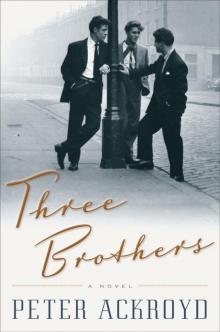 Three Brothers
Three Brothers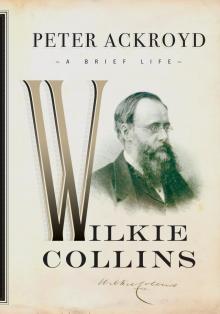 Wilkie Collins
Wilkie Collins Venice
Venice Poe
Poe The Lambs of London
The Lambs of London London
London Queer City
Queer City Revolution, a History of England, Volume 4
Revolution, a History of England, Volume 4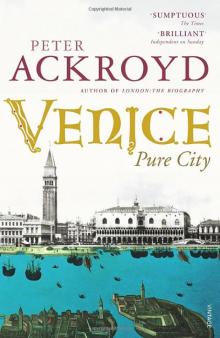 Venice: Pure City
Venice: Pure City Foundation
Foundation Thames
Thames The Plato Papers
The Plato Papers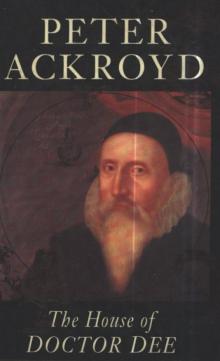 The house of Doctor Dee
The house of Doctor Dee Rebellion: The History of England from James I to the Glorious Revolution
Rebellion: The History of England from James I to the Glorious Revolution Albion: The Origins of the English Imagination
Albion: The Origins of the English Imagination The Fall of Troy
The Fall of Troy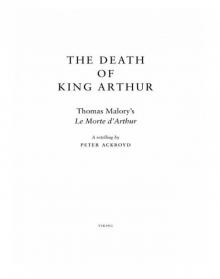 The Death of King Arthur
The Death of King Arthur The Trial of Elizabeth Cree
The Trial of Elizabeth Cree London: The Biography
London: The Biography The Casebook of Victor Frankenstein
The Casebook of Victor Frankenstein Hawksmoor
Hawksmoor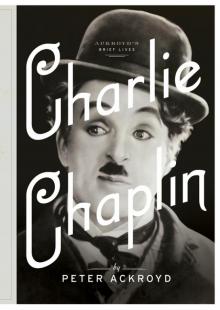 Charlie Chaplin
Charlie Chaplin London Under
London Under